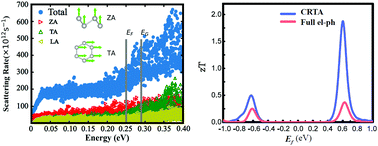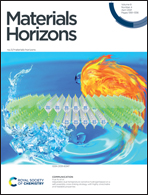Thermoelectric performance of 2D materials: the band-convergence strategy and strong intervalley scatterings†
Abstract
The strategy of band convergence of multi-valley conduction bands or multi-peak valence bands has been widely used to search or improve thermoelectric materials. However, the phonon-assisted intervalley scatterings due to multiple band degeneracy are usually neglected in the thermoelectric community. In this work, we investigate the (thermo)electric properties of non-polar monolayer β- and α-antimonene considering full mode- and momentum-resolved electron–phonon interactions. We also analyze thoroughly the selection rules on electron–phonon matrix-elements using group-theory arguments. Our calculations reveal strong intervalley scatterings between the nearly degenerate valley states in both β- and α-antimonene, and the commonly-used deformation potential approximation neglecting the dominant intervalley scattering gives inaccurate estimations of the electron–phonon scattering and thermoelectric transport properties. By considering full electron–phonon interactions based on the rigid-band approximation, we find that, the maximum value of the thermoelectric figure of merits zT at room temperature reduces to 0.37 in β-antimonene, by a factor of 5.7 compared to the value predicted based on the constant relaxation-time approximation method. Our work not only provides an accurate prediction of the thermoelectric performances of antimonenes, which reveals the key role of intervalley scatterings in determining the electronic part of zT, but also exhibits a computational framework for thermoelectric materials.



 Please wait while we load your content...
Please wait while we load your content...